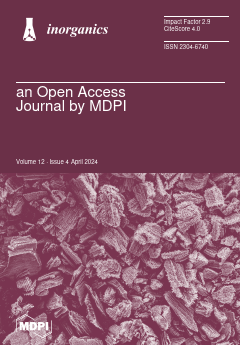Lithium perchlorate-doped polypyrrole growing on titanium substrate (LiClO
4-PPy/Ti) has been fabricated to act as electroactive electrode material for feasible electrochemical energy storage. A theoretical and experimental investigation is adopted to disclose the conductivity, electroactivity properties and interfacial interaction-dependent capacitance of LiClO
[...] Read more.
Lithium perchlorate-doped polypyrrole growing on titanium substrate (LiClO
4-PPy/Ti) has been fabricated to act as electroactive electrode material for feasible electrochemical energy storage. A theoretical and experimental investigation is adopted to disclose the conductivity, electroactivity properties and interfacial interaction-dependent capacitance of LiClO
4-PPy/Ti electrode. The experimental measurement results disclose that LiClO
4-PPy/Ti reveals lower ohmic resistance (0.2226 Ω cm
−2) and charge transfer resistance (2116 Ω cm
−2) to exhibit higher electrochemical conductivity, a more reactive surface, and feasible ion diffusion to present higher double-layer capacitance (0.1930 mF cm
−2) rather than LiClO
4/Ti (0.3660 Ω cm
−2, 65,250 Ω cm
−2, 0.0334 mF cm
−2). LiClO
4-PPy/Ti reveals higher Faradaic capacitance caused by the reversible doping and dedoping process of perchlorate ion on PPy than the electrical double-layer capacitance of LiClO
4/Ti caused by the reversible adsorption and desorption process of the LiClO
4 electrolyte on Ti. Theoretical simulation calculation results prove that a more intensive electrostatic interaction of pyrrole N···Ti (2.450 Å) in LiClO
4-PPy/Ti rather than perchlorate O···Ti (3.537 Å) in LiClO
4/Ti. LiClO
4-PPy/Ti exhibits higher density of states (57.321 electrons/eV) at Fermi energy and lower HOMO-LUMO molecule orbital energy gap (0.032 eV) than LiClO
4/Ti (9.652 electrons/eV, 0.340 eV) to present the enhanced electronic conductivity. LiClO
4-PPy/Ti also exhibits a more declined interface energy (−1.461 × 10
4) than LiClO
4/Ti (−5.202 × 10
3 eV) to present the intensified interfacial interaction. LiClO
4-PPy/Ti accordingly exhibits much higher specific capacitances of 0.123~0.0122 mF cm
−2 at current densities of 0.01~0.10 mA cm
−2 rather than LiClO
4/Ti (0.010~0.0095 mF cm
−2, presenting superior electroactivity and electrochemical capacitance properties. LiClO
4-PPy/Ti could well act as the electroactive supercapacitor electrode for feasible energy storage.
Full article





